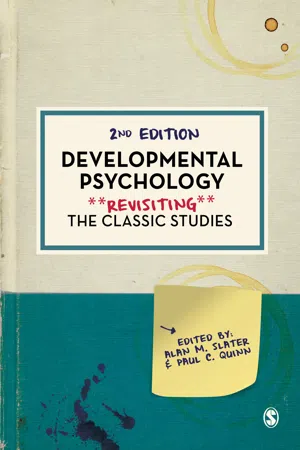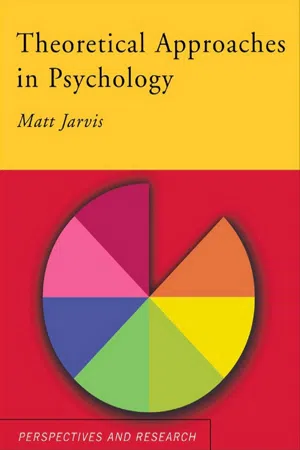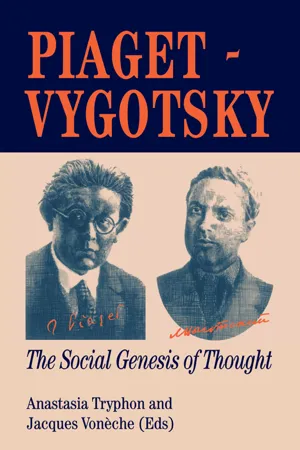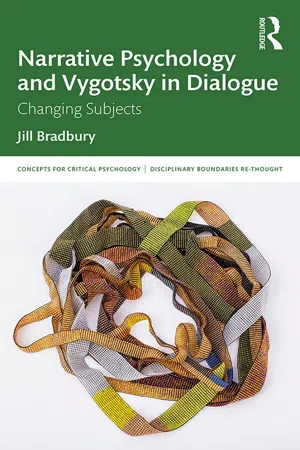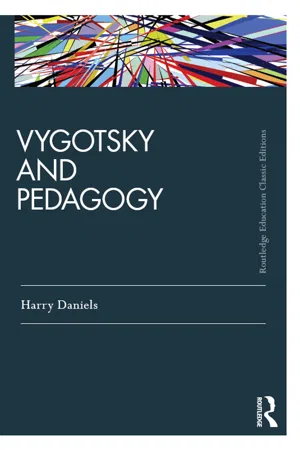Psychology
Vygotsky's theory of cognitive development
Vygotsky's theory of cognitive development emphasizes the role of social interaction and cultural context in shaping a child's mental development. He proposed the concept of the zone of proximal development, which refers to the gap between a child's current abilities and their potential abilities with the help of a more knowledgeable other. Vygotsky's theory highlights the importance of social and cultural influences on cognitive growth.
Written by Perlego with AI-assistance
Related key terms
Related key terms
1 of 4
Related key terms
1 of 3
12 Key excerpts on "Vygotsky's theory of cognitive development"
- eBook - ePub
Child and Adolescent Psychology for Social Work and Allied Professions
Applied Perspectives
- Gabriela Misca, Peter Unwin(Authors)
- 2018(Publication Date)
- Bloomsbury Academic(Publisher)
As highlighted above, one of the limitations of Piaget’s theory was the lack of consideration given to the social and cultural context of cognitive development. By contrast, Vygotsky’s theory (1978) focuses on the social and cultural processes where learning takes place as a main determinant of cognitive development.Cognitive development is seen as the result of children’s interaction with ‘experts’ – members of their own culture: parents, teachers, older/ more experienced children/peers or siblings. Such interactions most benefit the development of more complex abilities such as language and complex problem solving. When children and their ‘expert’ partner solve problems together, the child will develop beyond his/her current capabilities; this is called ‘zone of proximal development’, which is seen crucially as the child’s potential for development through social experience. While in Piaget’s theory the infant child was seen as a ‘lone scientist’ discovering the world, Vygotsky’s approach emphasizes the collective and social dimension of development through support from more experienced members of the culture.Zone of proximal development and scaffoldingThe concept of zone of proximal development enables us to understand how cognitive development arises from interactions with more experienced partners. However in order to be effective, the zone of proximate development needs to provide stimulation within the immediate developmental proximity. If the gap is too wide, the stimulation fails to support development. The role of the more experienced partner is to break down complex tasks, model and encourage and support the learner.Another important concept proposed by the socio-cultural theory is that of scaffolding. In scaffolding, the amount and type of support is adjusted to the child’s needs. For example, the amount of support is gradually decreasing, enabling the child to ultimately perform the task on his own.Reflective point: Emotional scaffoldingScaffolding is what the adult (or more skilled partner) does to move the child through the zone of proximal development to independent performance. The concept of scaffolding can be applied across a variety of contexts and content areas. For example, it has been suggested that children who are not provided with the words and concepts to recognize and understand their feelings (‘emotional scaffolding’) find it difficult to regulate their emotions, leading to a range of emotional and behavioural issues (Howe & Fearnley, 1999). - eBook - ePub
Developmental Psychology
Revisiting the Classic Studies
- Alan M Slater, Paul C Quinn, Alan M Slater, Paul C Quinn(Authors)
- 2020(Publication Date)
- SAGE Publications Ltd(Publisher)
Despite having been written nearly a century ago, Vygotsky’s critique of other theoretical views about learning and development and the ideas he introduces in this paper are relevant today. When his ideas became known, his perspective about the culturally organized and socially mediated nature of learning and intellectual development was not previously available in developmental science (Schaffer, 2006). His view overcomes some of the limitations of approaches that focus on cognitive development as determined solely by mechanisms inside the individual. It is true that Vygotsky’s assertion that development occurs at the “child-society border” has been difficult for some Western-trained scientists to understand after years of doing research aimed at separating the individual child and the external world (Kessen, 1979). Yet Vygotsky’s view has been useful in helping to direct the attention of researchers to the social and cultural origins of thinking along with the historical-cultural context of intellectual growth. These ideas are relevant to studying many of the concerns raised in today’s world.Vygotsky’s ideas about learning and development have also increased awareness of the role of the immediate social context in learning and cognitive development, and challenged developmental researchers to explore the role of context in greater depth. His emphasis on collaborative problem solving with more skilled partners has been influential in the learning sciences (Göncü & Gauvain, 2012; Sawyer, 2014) and developmental researchers have demonstrated the value of this approach in studies of children’s learning in many areas of cognition including attention, memory, problem-solving skills, and planning (Gauvain, 2001). This research shows that children’s understanding and cognitive skills can indeed be improved when adults or more skilled peers provide them with appropriate support for learning. His notion of the zone of proximal development, in particular, has given rise to several important concepts such as scaffolding (Wood, Bruner, & Ross, 1976) and guided participation (Rogoff, 1990). In addition, it coincides with the growing interest in microgenetic change that occurs over a learning experience (National Academies of Sciences, Engineering, and Medicine, 2018; Siegler, 2006). Vygotsky’s ideas are also relevant to studying child development during cultural change, a topic that is garnering significant interest during this period of rapid societal change in the context of globalization (Gauvain & Munroe, 2018). - eBook - ePub
- Matt Jarvis(Author)
- 2005(Publication Date)
- Routledge(Publisher)
Vygotsky was a contemporary of Piaget, writing in the Soviet Union during the 1920s and 1930s. His work was not published in the Western world, however, until the 1960s, since which time it has grown hugely in influence. Vygotsky was an admirer of Piaget’s and while he agreed with Piaget that cognitive development takes place in stages characterised by different styles of thinking, he disagreed with Piaget’s view of the child as exploring the world alone and forming its own internal representation of reality.The social and cultural basis of learning
Whereas Piaget saw children as learning by individual discovery, Vygotsky placed more emphasis on the role played by adults and other children in facilitating the child’s development. According to Vygotsky children are born with relatively basic mental functions such as the ability to perceive the outside world and to focus their attention. However, children lack higher mental functions such as memory, thinking and problemsolving. These higher mental functions are seen as ‘tools’ of the culture in which the individual lives and they are cultural in origin. Tools are transmitted to children by older members of the culture during guided learning experiences. Experiences with other people gradually become internalised and form the child’s internal representation of the world. Thus the way each child thinks is shared with other members of its culture.The zone of proximal development
Vygotsky believed that although children would eventually learn some concepts on their own during everyday experience they could develop far more during interaction with others. Children could never develop formal operational thinking without the help of others. Vygotsky called the difference between what a child can learn on its own and what it could potentially learn through interaction with others the zone of proximal development (ZPD). Whereas Piaget believed that the limiting factor in what a child could learn at any time was its stage of development, Vygotsky believed that the crucial factor was the availability of other ‘experts’ who could instruct the child. Unlike Piaget Vygotsky emphasised instruction from others in how to do things in order for the child to achieve its potential. As the child progresses through a zone of proximal development, or learning cycle, the amount of instruction will reduce. At first explicit and detailed instructions are needed, but later on hints and prompts are all that are needed to help the child progress. - eBook - ePub
Piaget Vygotsky
The Social Genesis Of Thought
- Anastasia Tryphon, Jacques Vonèche, ANASTASIA TRYPHON, Jacques Vonèche(Authors)
- 2013(Publication Date)
- Psychology Press(Publisher)
CHAPTER NINE Social interaction and individual understanding in a community of learners: The influence of Piaget and Vygotsky Ann L. Brown University of California, Berkeley, USA Kathleen E. Metz University of California, Riverside, USA Joseph C. Campione University of California, Berkeley, USA The importance of social interaction as a major force in cognitive development has become associated in America with Vygotskyan theory. In contrast, Piagetian theory has been seen as influential in mapping individual cognitive growth. However the two theorists have more in common than is usually supposed. Vygotsky’s central interest was in the evolution of cognitive processes, in growth and change rather than static state cognition. It is therefore not surprising that Vygotsky had a special interest in children’s learning, where one can observe cognitive processes “undergoing change right before one’s eyes.” 1 For Vygotsky, developmental analysis was central to psychological investigation in general, not just a peripheral offshoot having to do with the specialised study of children. If Vygotsky was more interested in individual cognitive development than is usually thought, Piaget was not immune to the role of social experiences. In particular, Piaget regarded peer interaction as an ideal forum for helping children “decentre” their thinking from one particular egocentric view in order to consider multiple perspectives. Faced with a group of peers who not only fail to accept his or her views but hold opposing opinions, the child must compromise. In the process of compromising, the group produces a solution that is more mature than each individual effort - eBook - ePub
A Vygotskian Analysis of Children's Play Behaviours
Beyond the Home Corner
- Zenna Kingdon, Zenna Kingdon(Authors)
- 2020(Publication Date)
- Routledge(Publisher)
Vygotsky is concerned with the ways in which learners make progress, focussing on process as well as product in assessment (Daniels 2001). He puts the child at the centre of the learning process, seeing the child as an active constructor of knowledge. Vygotsky considers play to be central to child development. Vygotsky posited that it was as a direct result of the child’s interactions with more knowledgeable others and social interactions with members of his community that the child developed the necessary apparatus for thinking and learning (Smith et al. 2003:493). Vygotsky stressed that learning took place within the specific culture in which the child existed clearly demonstrating that cognitive development does not occur in isolation but as an aspect of socio-cognitive context. A central tenet of his work was concerned the Zone of Proximal Development, something that a child can do today with support but tomorrow may be able to complete unassisted (Vygotsky 1978).Vygotsky’s work is marked by three distinct phases and conceptual shifts (Daniels 2001, Minick 2005). The first phase of Vygotsky’s research took place between 1925 and 1930. During this phase, he concentrated on an analytical unit which he refers to as the instrumental act. In this phase, stimulus-response was the foundation for learning and behaviour in humans and animals. He argues that speech gave humans an exclusive form of stimuli to control their behaviour; it is a mechanism common to both social behaviour and psychological processes, whilst being unique to humans (Minick 2005). During the second phase from 1930 to 1932, his focus moves to psychological systems, arguing that psychological research must focus not on the development of new mental functions but on the relationships between them and the development of psychological systems (Minick 2005). These psychological processes are known as higher mental functions and included voluntary attention, voluntary memory, and rational, volitional, goal-directed thought (Minick 2005). The last 2 years of Vygotsky’s life were marked by his greater and greater emphasis on the analysis of the development of psychological systems and their relationship with social behaviour (Daniels 2001). The significance of Vygotsky’s contributions to social theory is his study of general and meta-theory that underpins psychological phenomena (Daniels 2001). In 1932, Vygotsky delivered a series of lectures in Leningrad, which he later published as Thinking and Speech in 1934 (Minick 2005). In 1932, he also completed a critique of Piaget’s work on children’s egocentric speech (Minick 2005). Vygotsky recognises that psychology owes much to the work of Piaget. He believes that it is no exaggeration to say that Piaget revolutionised research concerning children’s thought and speech. In his text Thought and Language - eBook - ePub
- Harry Daniels(Author)
- 2008(Publication Date)
- Routledge(Publisher)
the basic psychological prerequisites for the historical development of behavior. Labor and the associated development of human speech and other psychological signs with which primitives attempt to master their behavior, signify the beginning of the genuine cultural or historical development of behavior. Finally, in child development, along with processes of organic growth and maturation, a second line of development is clearly distinguished – the cultural growth of behavior. It is based on the mastery of devices and means of cultural behavior and thinking.(Luria and Vygotsky, 1930, p. xi)Again, the methodological challenges are clear and these will be explored in Chapters 2 , 6 and 7 .I will now consider aspects of Vygotsky’s theory which follow from the themes identified by Wertsch (1985a): namely reliance on a genetic, or developmental method; the claim that higher mental functioning in the individual has its origins in social life; and the claim that an adequate account of human mental functioning must be grounded in an analysis of the tools and signs that mediate it. I will make specific reference to his work on scientific and everyday concepts, lower and higher elementary functioning, the zone of proximal development and the relation between sense and meaningScientific and everyday concepts
Vygotsky (1987a) and his co-worker Shif were particularly interested in two types of concepts: the scientific and the everyday or spontaneous. Using the term ‘scientific concepts’, Vygotsky referred to concepts introduced by a teacher in school; while spontaneous concepts were those that were acquired by the child outside contexts in which explicit instruction was in place. Scientific concepts were described as those which form a coherent, logical hierarchical system. For Vygotsky, scientific concepts were characterised by a high degree of generality and their relationship to objects is mediated through other concepts:the dependence of scientific concepts on spontaneous concepts and their influence on them stems from the unique relationship that exists between the scientific concept and its object… [T]his relationship is characterised by the fact that it is mediated through other concepts. Consequently, in its relationship to the object, the scientific concept includes a relationship to another concept, that is it includes the most basic element of a concept system. - eBook - ePub
Narrative Psychology and Vygotsky in Dialogue
Changing Subjects
- Jill Bradbury(Author)
- 2019(Publication Date)
- Routledge(Publisher)
the ) properly psychological question. And the answer that ubuntu provides us with is that humanity is defined relationally, not only when these relations are positive and humane, but inevitably and inextricably. The dialectical process of our relations with each other consists of morphing syntheses of good and bad, beauty and terror, competition and collaboration. Our actions towards others impact not only on their lives but on ours too; selves are formed relationally, reciprocally and reflexively. From this perspective then, the subject of psychology is not the “individual” because as Tutu, without elaborating on his meaning, somewhat enigmatically states, “the solitary individual is a contradiction in terms” (1999, p. 22). The implications for psychology is that our unit of analysis cannot be the abstract individual, even where we explicitly recognise the influences of the cultural, historical and political contexts within which such individuals live. The concept of ubuntu challenges this dichotomous framing and provokes us to rethink personhood.Vygotskian theory: relational consciousness
Mirroring the argument I have just developed about “ubuntu” I would like to suggest that the conceptual force of Vygotsky’s theory is to be found in his unique analysis of the relations between individual minds and social relations or societal formations. Although Vygotsky’s name is as well known as Freud’s or Piaget’s, the impact of his theory has been far less pervasive both within and beyond the discipline of psychology. The “zone of proximal development” serves as the touchstone of the theory, instantiating Vygotsky’s argument that the potential of mind develops in society , in relation with others.The world is mediated for human children, who encounter the world and its objects through others or through the understanding of others. In this way, each successive generation can (and cannot but) build on and develop the culture and knowledge of the previous generation whose lives overlap with and accompany them in their engagement with the present. The extended temporal zones of human development in shared intergenerational life provide the scope for education or the optimistic, progressive future-orientated zone of proximal development (ZPD). In Vygotsky’s famous law of sociogenesis:[E]very function in the cultural development of the child appears on the stage twice, in two forms – at first as social, then as psychological; at first as a form of cooperation between people, as a group, an intermental category, then as a means of individual behaviour, as an intramental category. This is the law for the construction of all higher mental functions.(Vygotsky, 1998, p. 169) - eBook - ePub
- Harry Daniels(Author)
- 2016(Publication Date)
- Routledge(Publisher)
The maturation of the child’s higher mental functions occurs in this co-operative process, that is, it occurs through the adult’s assistance and participation. In the domain of interest to us, this is expressed in the growth of the relativeness of causal thinking and in the development of a certain degree of voluntary control in scientific thinking. This element of voluntary control is a product of the instructional process itself…. In a problem involving scientific concepts, he must be able to do in collaboration with the teacher something that he has never done spontaneously … we know that the child can do more in collaboration that he can independently. (Vygotsky, 1987, pp. 168, 169, 216) The zone of proximal development Schneuwly (1994) discussed Vygotsky’s theory of development in terms of the individual’s reorganisation of lower psychological functions to form new higher ones whilst emphasising that psychological functions are themselves historical-cultural constructions. He viewed the concept of zone of proximal development (ZPD) as the theoretical attempt to understand the operation of contradiction between internal possibilities and external needs that constitutes the driving force of development. The concept of ZPD was created by Vygotsky as a metaphor to assist in explaining the way in which social and participatory learning takes place (John-Steiner and Mahn, 1996). The general genetic law of cultural development asserts the primacy of the social in development. I have sought to emphasise that Vygotsky was concerned to develop an account in which humans were seen as ‘making themselves from the outside’. Through acting on things in the world they engage with the meanings that those things assumed within social activity. Humans both shape those meanings and are shaped by them. This process takes place within the ZPD. This well-known concept is often cited as Vygotsky’s most profound contribution to educational debate - eBook - ePub
- David Scott, Eleanore Hargreaves, David Scott, Eleanore Hargreaves(Authors)
- 2015(Publication Date)
- SAGE Publications Ltd(Publisher)
For example, it is possible to ‘internalise’ a wristwatch if a person is able to use the watch as part of controlling their actions, for example, to leave a party to catch the last bus home. The internalised action still involves extra-corporal aspects, i.e. the watch is an auxiliary stimulus used to control action, but the critical issue here is that the individual has been able to master self-control of their actions in using the watch. The idea of ‘internalised’ is a way to refer to the transformation of self-control, rather than a particular bodily location for this control. If internalisation is interpreted biologically, then it is likely to generate images that confuse rather than illuminate cultural-historical theory.A COMMENT ABOUT ZPD
The concept, zone of proximal development, as developed by Vygotsky, describes a structural relation used in conceptualising human development. The concept has been widely misinterpreted (and misunderstood) as being part of a learning process or as an individual learner characteristic. Unfortunately, these misunderstandings are well established in both scientific and popular usage. The distortions introduced by these misunderstandings obscure Vygotsky's important use of the concept to form a hypothesis about the relation between instruction and psychological development.Vygotsky conceptualises development as organised in age periods, where each period is historically formed and characterised as a configuration of psychological functions. The zone for the next development refers to the functions that a child must acquire to move from one age period to another. Part of the conceptual force of the idea can be understood by considering that the individual acquisition of a new higher psychological function enables qualitatively new possibilities for action (e.g. speech, writing, conceptual thinking) for the person. Vygotsky's basic point was that instruction should be focused on developing functions that are important for the next development, for example, ‘[w]e have given the child a penny's worth of instruction and the consequence has been a dollar's worth of development’ (Vygotsky, 1987 [1934]: 198). Chaiklin (2003b) provides a detailed reconstruction of Vygotsky's concept, underpinned by an examination of the available texts.LEARNING ACTIVITY
School-based instruction is a significant societal practice where the achievement of learning is central. Vygotsky's studies of everyday and academic concepts, by his own analysis, were not an adequate theoretical basis for designing school instruction. Vygotsky's (1987 [1934]: 239) analysis was focused on general features of concept learning rather than particular content, even though he recognised ‘the mutually conditioned nature, the organic integration, and the internal unity of content and form in the development of thinking’ (1987 [1934]: 132); in other words, that thinking and knowledge must be analysed in relation to content. Furthermore, he did not ‘address the internal connections in the system’ of concepts, which is ‘a fundamental issue concerning the development of the concept system’ (1987 [1934]: 240). Subsequent developments in the cultural-historical tradition have addressed these shortcomings in a substantial way. - eBook - ePub
Catching Readers Before They Fall
Supporting Readers Who Struggle, K-4
- Pat Johnson, Katie Keier(Authors)
- 2023(Publication Date)
- Routledge(Publisher)
1986 ). Following the list, we elaborate on these foundational concepts, putting them into practical terms with examples that are more closely connected to you and your classroom.- Teaching is most effective (and learning is most likely to happen) when it takes place within the child’s zone of proximal development.
- Language is a central tool of humans and, when used appropriately in teach-ing/learning situations, can play a crucial role in children’s cognitive development.
- The sociocultural aspect of teaching and learning is important and includes developing environments for learning that foster lots of talk, interaction, and joint projects.
Zone of Proximal Development
Have you ever wondered whether or not your students are actually learning what you are teaching? We have. We have had times when we thought we were teaching our hearts out only to realize that nothing much sunk into the children’s brains. So were we really teaching then? We thought we were, but how can teaching exist without learning?For us, Vygotsky’s concept of the ZPD answers the question, Where does effective teaching really lie? Vygotsky’s answer: You are doing your best teaching when you are working within the child’s zone of proximal development. He defines ZPD as where the child can do it with your help (Vygotsky 1986 ). When you teach children within their zone of proximal development, they have the highest potential for successful learning. They see the task, skill, or strategic thinking modeled by you, they do it together with you, and eventually they take on the new learning independently as you back off your supports.We have adapted a graphic explanation of ZPD from FrankSmith’s book The Book of Learning and Forgetting (1998). Refer to Figure 3.1 - eBook - ePub
- René van der Veer, Richard Bailey(Authors)
- 2014(Publication Date)
- Bloomsbury Academic(Publisher)
The second point to note is that the dual testing procedure involves the social-individual dimension. After all, what is claimed is that what the child can do now in cooperation, it will be able to do tomorrow independently. In other words, it is suggested that joint problem-solving actions precede and partially create individual problem-solving behavior. And we can now see clearly why the idea of the zone of proximal development must have appealed strongly to Vygotsky. After all, in Chapter 3 we have seen that for Vygotsky all higher mental functions originate in social interaction. He even stated a so-called sociogenetic law:In general we might say that the relations between higher mental functions once were genuine relations between people . . . Every function in the cultural development of the child appears twice, in two planes, first, the social, then the psychological, first between people as an interpsychological category, then within the child as an intrapsychological category.(Vygotsky 1931/1983, pp. 142–5)This sociogenetic law essentially stated that higher mental processes and self-regulation originate in social interaction with a more able partner. What the child can do in cooperation now, it can do independently tomorrow. The stage of joint performance precedes that of autonomous performance. Now, the concept of the zone of proximal development seems a perfect illustration of that law. The test performance with help indicates the interpsychological stage of problem solving; the test performance without help the intrapsychological stage. What may have appealed to Vygotsky in the concept of the zone of proximal development was that it seemed a transposition of the idea of the sociogenetic law to the domain of prognosis. In that respect, the help and hints provided in a joint problem-solving situation are similar to the colored cards in the forbidden colors task (see Chapter 3). Both are essentially cultural tools provided by more able partners that the child utilizes to solve a problem. As the child grows older it will internalize these tools or shift to others in order to be able to solve the task independently. Because joint problem-solving precedes and partially creates individual problem solving (the sociogenetic law) the one can be used to predict the other (the concept of the zone of proximal development). - eBook - ePub
- Irving B. Weiner, William M. Reynolds, Gloria E. Miller(Authors)
- 2012(Publication Date)
- Wiley(Publisher)
Vygotsky's (1987) examination of the relationships between first and second language acquisition shows how both “represent the development of two aspects of a single process, the development of two aspects of the process of verbal thinking. In foreign language learning, the external, sound and phasal aspects of verbal thinking [related to everyday concepts] are the most prominent. In the development of scientific concepts the semantic aspects of this process come to the fore” (pp. 222–223). He added another comparison between learning scientific concepts and learning a second language. The meanings that a student is acquiring in a second language are mediated by meanings in the native language. Similarly, prior existing everyday concepts mediate relationships between scientific concepts and objects (Vygotsky, 1987). Vygotsky cautions, however, that “the learning of the native language, the learning of foreign languages, and the development of written speech interact with each other in complex ways. This reflects their mutual membership in a single class of genetic processes and the internal unity of these processes” (Vygotsky, 1987, p. 179). The unity Vygotsky found in inner speech, verbal thinking, and meaning has been a focus for sociocultural researchers, especially those looking at these three aspects in second-language learners who are trying to create meaning in a new language.Sociocultural Approaches to Second-Language Acquisition and Development
Researchers interested in diverse facets of second-language acquisition both in and out of educational contexts, have utilized sociocultural theory in a variety of ways. Some have focused more on the internal aspects of language, the mental processes involved in making and communicating meaning through language acquisition, while others have focused more on the social, cultural, physical, and historical contexts of second-language learning and acquisition. All have strived to understand second-language learning and acquisition and examine the role of sociocultural context as a mediating force in language development and use and have recognized the essential role of semiotic mediation—making meaning through signs—in the development of the mind.James Lantolf has played a central role in developing a sociocultural approach to the study of second-language acquisition (SLA) and second-language teaching/learning. He and his students and colleagues have developed a methodological approach to researching second-language acquisition based on the work of Vygotsky using mediation; inner speech, private speech, and internalization; the regulatory function of language; the zone of proximal development and scaffolding; testing, including dynamic assessment. (Lantolf, 2000; Lantolf & Appel, 1994; Lantolf & Poehner, 2008; Lantolf & Thorne, 2006). Lantolf and Beckett (2009) reviewed sociocultural research investigating SLA from 1985 to the present. Mahn (2013) similarly describes aspects of Vygotsky's methodology and theory that have guided sociocultural approaches to SLA research.
Index pages curate the most relevant extracts from our library of academic textbooks. They’ve been created using an in-house natural language model (NLM), each adding context and meaning to key research topics.
Explore more topic indexes
Explore more topic indexes
1 of 6
Explore more topic indexes
1 of 4

